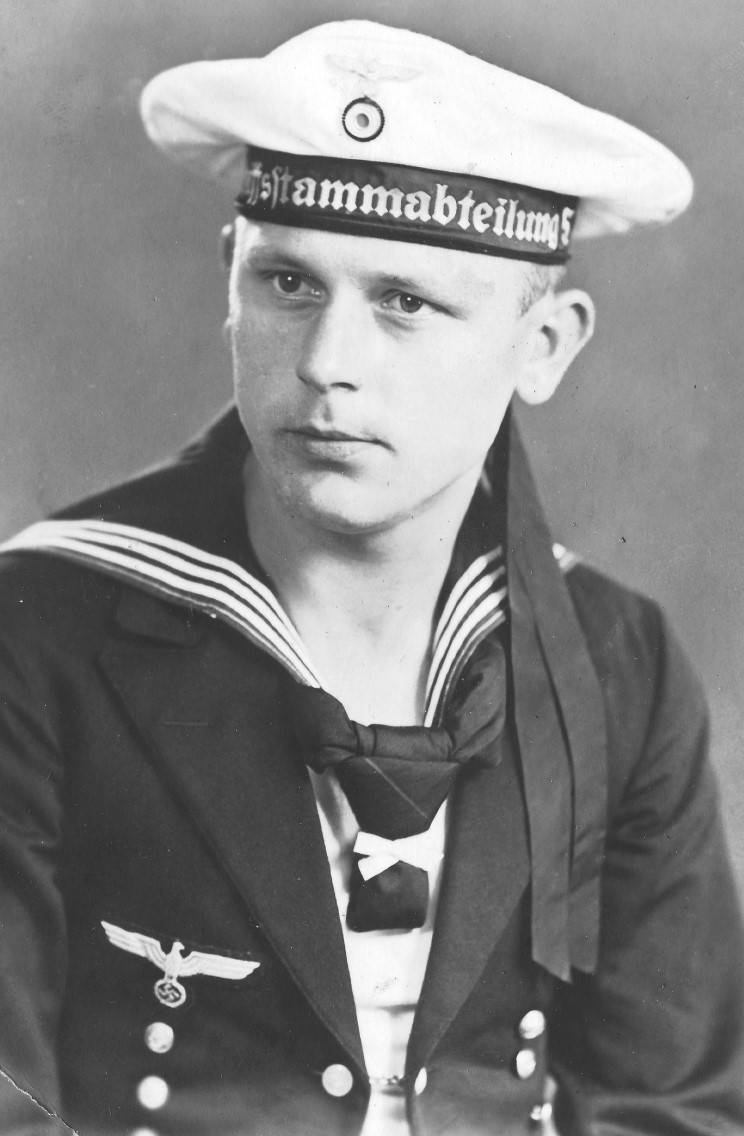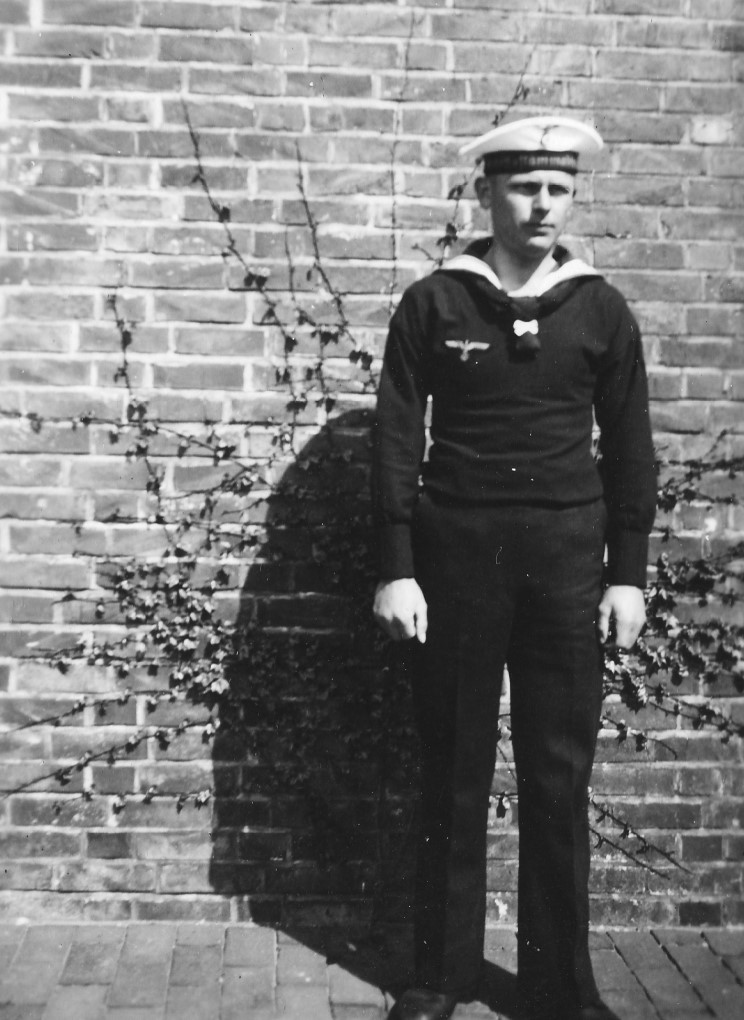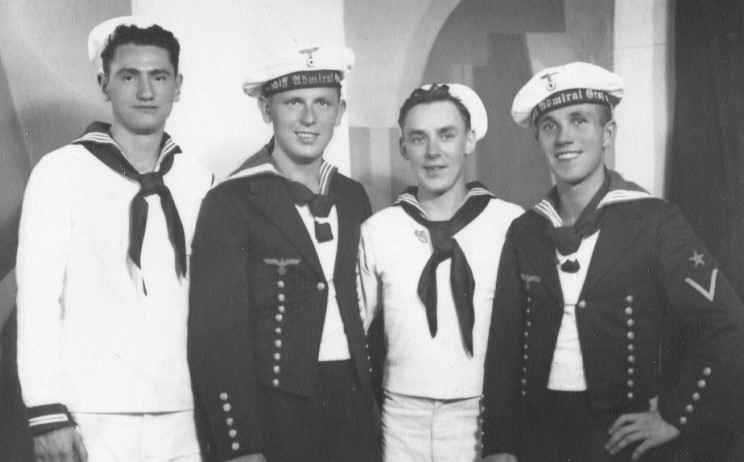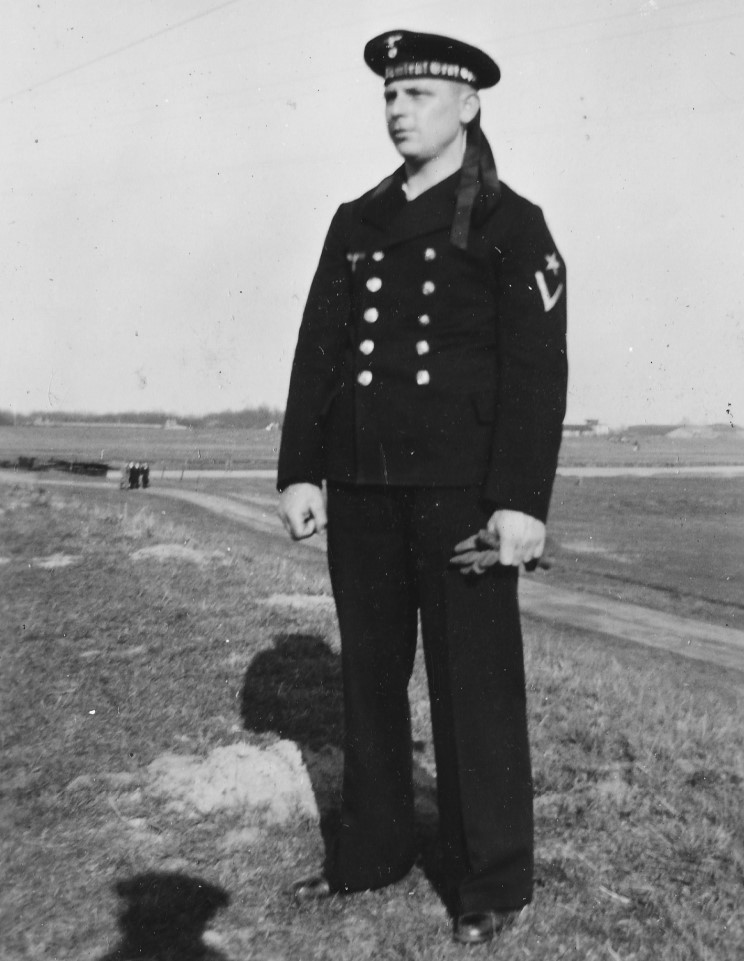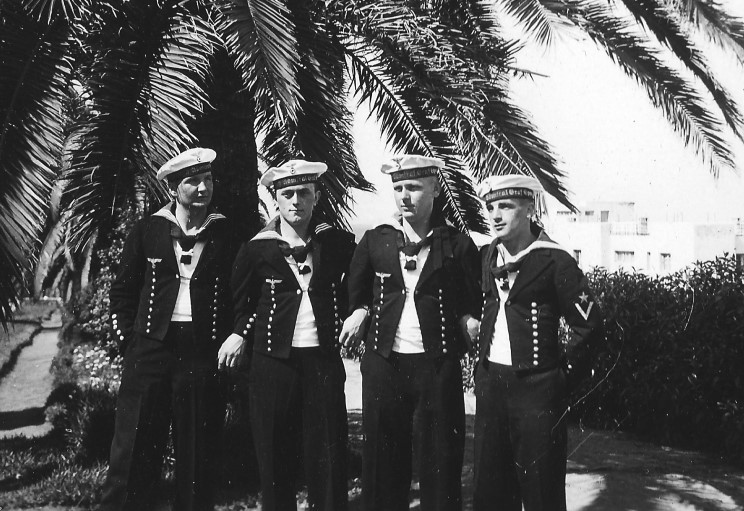As his birth certificate states, Heinrich Dick (Hein) was born the 7th of April, 1916 in Reddentin, a region of Schlawe, Pomerania. His father's name was Heinrich Rudolf and his mother's name was Emma Pioch. His father was one more soldier who fought in the First World War, and Hein was born as a result of his father's military furloughs. During the four long war years, Hein's father enjoyed only sporadic leave's of fifteen to twenty days each. The family was always numerous. The nucleus stayed united in spite of the distances. There were eight siblings; Franz was the oldest, and then came Karl, Marie, Elisabeth, Frieda, Emma, Hein and Paul.
Once the children reached legal age, they all began to look for work to help in the house. In 1935 Hein received a recruitment certificate to the RAD, (German Labor Service) in the town of Alt Kolziglow. This was an almost obligatory imposition by the term of a year for all young people after they reached certain age. Hein stayed in RAD six months more due to a delay of his military duties. While beginning that additional time, he was distinguished by his superiors with a promotion to a degree of the first hierarchy, Group Commander. After fulfilling his RAD service, and upon reaching eighteen years of age, Hein had to enter into Germany 's obligatory military conscription. Following his vocation to the sea, he presented a request to enter the German Navy, the Kriegsmarine.
One morning the mailman brought on large envelope prominently displaying the Kriegsmarine insignia, inside Hein found papers with a letterhead in the form of an eagle: sharp and laconic instructions, a card with his name to fasten on his clothes and a third class train ticket. It was the call to arms. The day of voluntarily joining the Third Reich Navy, was there. With a mixture of enthusiasm, and intrigue, he accepted the arrival of something he believed would change the course of his life forever.
On a cold April 1st of 1938, a day illuminated by an apathetic and sluggish sun, many young men aspiring to be sailors arrived at the dominions of the Fifth Unit School of Ship's Crews in Eckernförde. In no time they felt to be both owners and guests of the Second Company of the Fourth Battalion. Hein was properly dressed, armed and equipped. Day after day, he received basic instruction of infantry, close and open order, naval justice and target practice.
Suddenly, after six months of intense training, Hein fulfilled its yearning. His commander communicated his destiny to him, he was to present himself to the battleship Admiral Graf Spee, anchored to 7 buoy in Kiel. Hein received a train ticket, a four-day leave, and a list of elements and clothes to take. When his leave ended and
he found himself only meters away from his designated ship, he felt filled with mixed emotions, restlessness
and uneasiness. With uncertain feet, Hein disembarked from the small motor boat and climbed the ladder that lead to the main deck of the enormous Admiral Graf Spee.
He climbed timidly, keeping his head low, taking care not to stumble on the last steps. He saw steel and more steel. Three enormous, long, fearless, nearly obscene tubes faced him. It was the main artillery. Anchor chain, thick and brilliant, covered all the extension from the deck pipe to the hawse-hole. Above it materialized the
impressive structure of the main castle that straightened up arrogantly from the center of the Graf Spee. It was a bristle of cables, threads, masts, antennas, telemeters and reflectors.
In its front the word 'Colonel,' was written with white gothic letters on a black field, it was another tribute to navy to Vice-Admiral von Spee. The German military flag waved languidly on the main mast greeting the arrival of the inexperienced sailors. The emblem colors, red, black and white constituted the unique shade of color alive
in that amalgam of lead gray colors. The rest of the mechanisms and machines were painted of an opaque gray tone, almost dark.
The ship's crew, sub-officers and sailors, was organized in ten divisions of 120 men each. Hein was to join the
First Division, the one in charge of the great guns. He never knew if he was chosen merely by alphabetical order or by his height. His first impression told him it was his height or the alphabet, but he doubted it because he knew the navy selected positions based on personal abilities, and in school he had been good student. Especially in artillery matters.
Weeks later, on 6 October 1938, the battleship weighed anchor. The Graf Spee made port in Tangier on 16 October, and Vigo on the 18. In November, the ship spent fourteen days in the same operational zone, and lingered in the port of Bilbao after a fleeting return to Kiel. Nobody was given leave or respite. The Spee re-
supplied in record time and weighed anchor and sailed in the direction of similar waters.
March 1939 arrived, the cold yielded and the sun showed more frequently. The departure order was predicted for the 22 of that month. The Spee would participate in the celebrations of the return of the zone of Memel to the fold of the Great Reich. A Convention drawn in 1924, and named after that territory, imposed the transference of the region of the Memel, named after a small river crossed that it, from East Prussia to Lithuania. Hein participated and received a commemorative medal.
In April and May more important naval maneuvers were instituted. This time the contingent of ships was powerful and the intention was to evaluate the most modern units in action. The Fleet, commanded by Admiral Boehm, was composed by his ship, the Admiral Graf Spee, the twin battleships Deutschland and Admiral Scheer, the cruises Köln and Leipzig, the destroyer Diether von Roeder and the supply ship Erwin Wassner, six submarines type II and III belonging to the fleet, Saltzwedel, Hundius and Wegener and it support vessels.
Some units, among them the Spee, secured mooring cables in Rocha Count d`Obidos, Lisbon, at 10 A .M., on a bright sun shining morning on Saturday 6 May of 1939. A strong breeze shook the large flag and the smaller honor pennants, producing loud cracks that broke the expectant silence of the coast observers. From the water's edge the mute spectators admired the powerful German Navy mooring maneuver. On the evening of May 11, the Fleet weighed anchor, behind remained unfulfilled love, a bit of drunkenness and the desire to return some day.
The following scale was Ceuta. From the 29 May to 31 May, during great part of their passage, the Graf Spee escorted the ships that transported the Condor Legion on its return to Germany. Making that a rare occasion in that region of Germany, 21 August 1939, a Monday, presented itself as a warm and sunny summer day.
Little to no activity showed in the city and the port as the majority of the people took advantage of vacations
last days.
That evening, at nineteen hundred hours, history started its clock. In the middle of total silence and without the presence of authorities, well wishers, or of the band that always presided over the festive ceremonies of departing, the mighty battleship Graf Spee was ordered to cast off. Passing through the floodgates of the channel towards a trip without return, the Graf Spee moved away from the port, and like a shade, disappeared.
Only its Commander knew the orders, but he was unaware of the final turn of luck those one hundred and eighteen days later, destiny will provide to him, his men and his ship.
Hein was one of more than thousand sailors than would remain ignorant of his future. 1 September1939 found the Graf Spee steaming through the high seas. That day the die was cast, it was war!
In months of raids, encounters, flights and mysteries, the Spee sank nine English merchants. Before returning to Germany, Captain Hans Langsdorff, the Commander, decided to try their luck in the River Plate, South America's
river of silver. In those waters he encountered three British cruises. It was the dawn, several minutes later the German battleship began to take the first impacts of the shells fired by the English ships.
Hein found out about that later, because inside tower "A" they practically did not feel anything, although an 8 inch British shell hit target nearby on the starboard side. Hein, seated next to the fire control communications phone, did not heard or perceive the strong roars of the enemy projectiles. Everything that was going on outside of his post was deafened and covered by the noise of the firing emanating from their own 280 millimeter guns, the smell of burnt powder and the shouts of the service and operation. Much later, when the battle ended, they entered Montevideo. The thirty-six dead were buried with honors. After frantic diplomatic lobbying to remain in port failed, the Captain was forced to weigh anchor.
Another decision was then made, to save the crew from certain death. Buenos Aires sent two tugboats and one boat to meet the Graf Spee. The entire ship's crew boarded those tugboats and ship in a speedy concealed manner. Forty men remained on board the doomed German battleship. Only one bag was allowed for each two sailors. Later, Hein remembers very well what he carried while leaving the Graf Spee.
On his way to Buenos Aires and his new life, Hein wore a white uniform, packed blue trousers and shirts, the "Collani", a pair of shoes, a towel or two, a few books and photographs, and the wood box issued for personal effects. His bag companion highly protests that choice of carrying such big and unyielding piece of wood.
The Spee weighed anchor and five miles out, it was blow up. The tugboats maintained course to Argentina and arrived on the following day. The later events are well known, the suicide of the Graf Spee Commander and the internment of the crew. 1939 closed in that tragic way.
In 1940 it is decided to send to the sailors away from Buenos Aires and to the interior of Argentina. 20 March
1940, was Hein's turn to depart for yet another unknown place. He gathered clothes and memories as he prepared to leave Buenos Aires. Days before that departure date, his group was lead to the most fashionable men's clothing store of the Argentine Capital, the well-known and traditional Gath & Chaves located in Florida and Cangallo streets. They arrived in procession, a scaring sight to the spoiled employees.
The sailors were surprised by the greatness of the just inaugurated main hall, with its magnificent leaded glass brilliant skylight. They were provided with two gabardine suits, raincoat, hat, shirts, neckties and a warm overcoat. In that way the obligation of the brand new office of the Graf Spee, located in the German embassy, to maintain them well dressed, in the latest men's fashion was fulfilled.
From Buenos Aires, they traveled by train to Cordoba. There they were lodged in the quarters of the Cordoba Police Cavalry Squadron, which was located in the city's outskirts, and for a year they worked in the area.
Finally, on day of June of 1942 Hein's group received and orders to meet in the city of Cordoba. The reason,
said the concise part, was that they will move to another location and be housed there. That was to be in the Valley of Calamuchita. Hein had to take leave of his friends. He would not return until many years later, already married and with children, and in other circumstances.
Once arriving to their new destination, the 250 sailors began to erect the Colony of Old Chapel, their new home. They worked hard, they pooled their resources and money, they visited the nearby small town of 'El Sauce' ('The Willow') soon to become General Villa Belgrano), met people and settled down. They left their stamp in that beautiful valley, because they were specialists in many fields, and they were decided and enterprising.
By 1945 from being interned troops in a neutral country, they became military prisoners. (Argentina had declared war on the Axis), and from the police control they had been under, they went to be under Army control.
In that year of 1945, Hein had met Ana Maria Bousquet, Annie, who was of half French and half English ancestry.
Annie and Hein, a peculiar combination! Fell in love and married in September 1945. However, back in May, Germany had surrendered, and after that, between the now German prisoners of war, the rumor had begun that they would be repatriated. And so it was. During February of 1946, while the Argentineans enjoyed their summer vacations, the German sailors were rounded up, taken to Cordoba, and then to Buenos Aires and there with no further ado, embarked in the English steamship "Highland Monarch." That ship touched port in Montevideo, Freetown and Bilbao, arriving to the mouth of Elbe River, to be received by nothing less than by the Ajax, one of the very ships that the Admiral Graf Spee had encountered and fought off the Rover Plate.
After disembarking, the Graf Spee sailors were sent to an enormous field. It was Camp H of Zone A, and was located in the near town of Munster. Located in the British Zone, Camp H of Zone A, was the biggest
concentration camp of the German north, and it housed war prisoners of lesser ranks. The Camp held more than a million prisoners and its mission was to control, review and release the greatest amount of prisoners possible as long as they had a place to live.
Provisory documents, a small sum of money and train ticket to that final destination were issued to those lucky enough to have a place to go. Given license to leave the camp after a few weeks, Hein lodged in the house of his sister Emma, a widow with four children. There he reunited with his parents and some of his brothers; they had all run away from the east. Hein went to work hard in building houses and other construction. He constantly received letters from Annie, packages with coffee, oil, cigarettes, tobacco, shoes and socks, overcoats and even shoelaces.
After years of tension and frustrations, Hein obtained permission to leave Germany, and at once embarked in the Argentine steamer"Entre Rios," that way, and using the passage ticket that Annie had paid with her teacher's salary he returned to Argentina. It was 1949. The encounter was emotional, together again; Hein and Annie fell back into the love and peace so long denied. After spending a few days in friendly Buenos Aires, they hurried to their town, "General Villa Belgrano." Ten years had passed from the battle that had delivered Hein to Argentina and a new world.
The forty remaining years in the life of Heinrich Dick were fruitful; he and Annie had four children. Thanks to his construction experience in post war Germany, Hein started to work as a builder in the hills of his beloved Cordoba. Soon he became an eminent businessman. He and Annie enjoyed traveling, raising and educating their children and became well known and loved in the Villa. Every December 20, the veterans of the Graf Spee meet to remember their ship, their friends, and their Commander, to whom many of them owed their life, and who is buried in the German cemetery of Buenos Aires.
During the forty year anniversary, old New Zealander sailors from the HMNZS Achilles came to present their respect and to recall those days. Of more than the thousand men crew of the mighty Graf Spee, half took root in Germany and the other in diverse countries, the majority in Argentina. A few months before the half century mark of the battle was to be commemorated, Hein's beloved Annie passed away.
Nevertheless, Hein recovered enough spirit to attend the acts in Cordoba, then Montevideo and Buenos Aires.
With certain sadness, but hopeful by the promise of his son Enrique Rodolfo to write a book on his life, Hein passed away on 19 of July, 1992. To the happiness of many and as a honor to the memory of Hein and all those boys of blue uniform, those young people, anxious and hard working who forever have left their footsteps in the roads of their new mother country, Argentina, Enrique Rodolfo Dick's book "After the wake of the Graf Spee" was published three years later.
(Versión en español)
-General Enrique R. Dick
